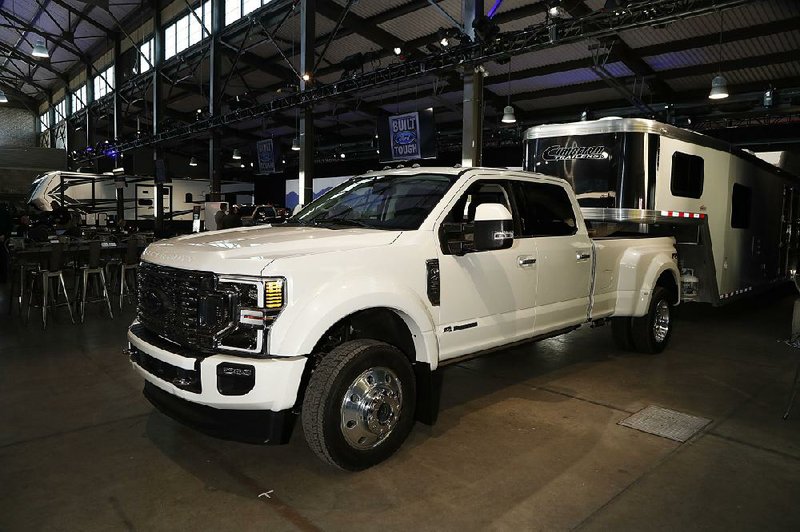DETROIT -- Nicole Foster-Beck asks a lot of the heavy-duty pickup she uses on her 43-acre horse farm east of Dallas.
Aside from the daily hauling, her 2015 GMC Sierra has to be powerful enough to pull a heavy eight-horse trailer to competitions, yet cushy enough to keep people comfortable on trips as far away as Kentucky.
She's exactly the type of customer all three Detroit automakers will be courting this year when they roll out new or substantially updated heavy-duty versions of their trucks. It's the first time in years that all three are revamping their heavy-duty trucks at the same time, which likely will touch off a battle of ads and specifications.
Pickups from the Detroit automakers were the three top-selling vehicles in the U.S. last year, totaling more than 2 million in sales. Heavy-duty versions, with bigger frames, beds, interiors and engines, make up about 30 percent of that. They're for those who need to tow and haul big things. Most buyers pull trailers with heavy items including boats, horses and recreational campers that can weigh about 10 tons. Many are used to pull trailers laden with equipment to job sites.
"Hauling a horse is not just like hauling around hay," said Foster-Beck, who trains show horses at Foster Farm near Dallas. "Your ability to accelerate when you need to, your ability to brake gently, those things really matter."
There's a lot at stake for the automakers, who get most of their profits from trucks. About 90 percent of heavy-duty truck buyers spend thousands of dollars extra for powerful diesel engines, and many go for pricey luxury and safety features, paying as much as $80,000 for a fully decked-out truck.
They also do their homework.
"Capability is really important for these folks," said Sandor Piszar, truck marketing manager for General Motors' Chevrolet brand. "They're oftentimes towing something that's even more valuable than the truck itself. It enables what their lifestyle is."
All three companies are offering cameras and other electronics to help with towing, backing up and viewing surrounding traffic, features that also are important to heavy-duty truck buyers.
Prices haven't been announced for any of the trucks.
Fiat Chrysler's Ram brand started this year's competition, unveiling a new heavy-duty pickup in January. The 2019 Ram, which goes on sale in April, has an optional 400-horsepower, 6.7-liter six-cylinder diesel engine. The company says it can pull more than 35,000 pounds and carry 7,680 pounds in its bed.
General Motors' GMC brand was next with the heavy-duty Sierra. Its 6.6-liter diesel engine has 445 horsepower.
In unveiling the heavy-duty Chevrolet Silverado on Tuesday in Flint, Mich., GM said the vehicle can tow up to 35,500 pounds with the diesel engine. The Silverado is nearly identical to the Sierra, which is a little more posh.
Both GM trucks will be offered with a new 401-horsepower 6.6-liter V8 gas engine with 464 pound-feet of torque and what GM says is stronger towing capability than its previous gas engine trucks.
The Silverado comes out in the middle of the year and the Sierra in late summer.
Also Tuesday, Ford unveiled a new Super Duty version of the F-Series -- F-250 up to F-450 -- and will put it on display at the weeklong Chicago Auto Show, which starts Saturday. It didn't release power numbers but said the new truck, due out in the fall, will offer the company's highest-ever towing and payload ratings. Ford also added a larger 7.3-liter V8 gasoline engine to its lineup, joining a smaller V8 and a 6.7-liter diesel engine. The larger gasoline V8 gives people more towing ability at a cost lower than a diesel engine, said Todd Eckert, Ford's truck marketing manager.
The automaker, which dominates the growing U.S. commercial-vehicle market, also is adding advanced safety features, such as automatic emergency braking and technology that keeps the trucks in their lanes.
Staying ahead is critical for Ford, which revealed recently that it earned $10 billion before interest and taxes in 2017 from its worldwide truck and van business, which generated $72 billion in revenue.
Ford's full-size F-Series has been the best-selling passenger vehicle in the U.S. for almost four decades. But Ram pickups have been coming on strong since new light-duty models hit the market last year. The Ram truck line outsold the Silverado -- traditionally No. 2 in the segment -- for the final three months of 2018.
Those rival brands now are aiming to take a chunk of Ford's 44.5 percent market share in North American commercial vehicles, used as work trucks in agriculture and other industries. It's a growth segment as total U.S. vehicle sales have begun to decline.
Deliveries of commercial vehicles in the U.S. grew 9 percent last year to 743,210 models, propelled by changes in tax policy that encouraged businesses to expand their fleets, said Michelle Krebs, senior analyst for researcher Autotrader. The added competition comes as sales are expected to moderate this year when the effects of those tax cuts fade.
Ford said the operating-profit margin for its worldwide truck and van business was 14 percent in 2017 -- far ahead of the 4.4 percent margin the company earned from all its auto operations last year.
"Trucks -- especially the bigger, more expensive ones -- contribute mightily to the bottom line," Krebs said. "And car companies have got to squeeze as much profit out of sales of their current models so they can finance this future" of self-driving and electric cars. "No one knows when it's coming and when it will be profitable."
Information for this article was contributed by Tom Krisher of The Associated Press and by Keith Naughton of Bloomberg News.
Business on 02/06/2019
